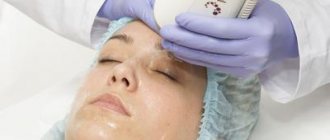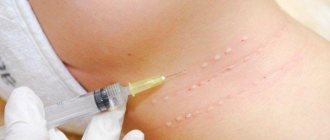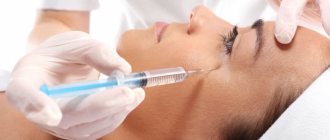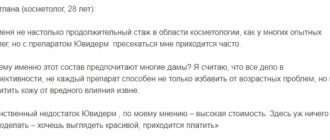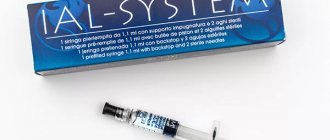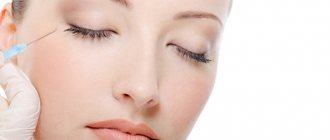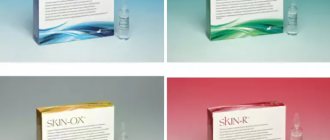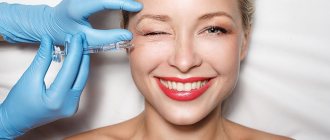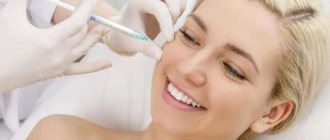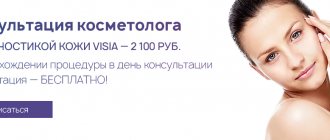Biorevitalization is the injection of hyaluronic acid obtained through a special biotechnological method. The direction is based on the ability of hyaluronic acid to interact with cell receptors and trigger the process of tissue regeneration. For injections, crossed or cross-linked hyaluronic acid is used; it lingers in the skin and does not dissolve as quickly as does the hyaluronic acid used in mesotherapy cocktails.
Hyaluronic acid is an excellent natural moisturizer and a natural component of our skin, responsible for its elasticity. With age, the amount of hyaluronic acid in the body decreases, which is why our skin loses moisture, elasticity, becomes dull, and wrinkles appear. The procedure can be performed on any area of the skin that requires hydration, most often on the face, neck, décolleté and hands.
Biorevitalization with hyaluronic acid
The method of biorevitalization with hyaluronic acid is indicated for all patients who, for one reason or another, have decreased skin turgor. The reasons can be very different. This can be natural aging, skin damage from UV rays, which often happens with excessive tanning, rapid, uncontrolled weight loss, illness or stress. The method has proven itself well in the rehabilitation period after aggressive procedures (peelings, polishing). For preventive purposes, biorevitalization is indicated 2 weeks before a trip to hot countries where there is active insolation and 10-14 days after returning.
Laser biorevitalization at the State Research Center of Laser Medicine.
At the State Scientific Center for Laser Medicine, the laser biorevitalization procedure has found wide specialized application along with other non-surgical and injection methods of skin rejuvenation and figure correction. This is largely due to the significant advantages that this method of combating premature aging has.
Indications for laser biorevitalization:
- The presence of facial wrinkles on the face and body;
- Obvious photoaging of the skin;
- Significant sagging and dry skin;
- Loss of skin elasticity.
If any of these indications are present, a specialist from the State Research Center for Laser Medicine may advise the patient to undergo laser biorevitalization in order to correct any deficiencies that have arisen and eliminate the first signs of aging.
Modern laser biorevitalization can be used on almost all areas of the face (including under the eyes on the lips) and décolleté. In addition, this procedure is increasingly being performed on the hands.
Effectiveness of procedures.
Today, laser biorevitalization provides lasting, guaranteed results by renewing the skin at the cellular level. The increasing effect of the course of procedures can be observed over several months.
Laser biorevitalization of the face: visible and hidden effect
After a course of laser therapy using this technique, patients experience:
- smoothing out fine wrinkles and wrinkled networks;
- smoothing skin texture;
- narrowing of enlarged pores;
- effect of moisturized glowing skin;
- rapid healing of the skin after thermal burns and other injuries;
- disappearance of scars, acne, eczema;
- increasing lip volume (with targeted actions).
Procedure:
Any laser rejuvenation procedure is carried out only after consultation with a specialist. If the patient has no contraindications to use, the doctor determines the treatment plan and its duration. A laser biorevitalization session consists of several successive stages:
- skin cleansing;
- soft peeling;
- opening pores for better penetration of the active substance;
- applying a base gel to the skin;
- laser treatment of the correction zone;
- applying an alginate mask.
The first skin changes become noticeable after the first laser biorevitalization procedure. To maximize and consolidate the effect, it is recommended to undergo a rejuvenation course of several sessions. The duration of therapy depends on the patient’s age, the type and condition of his skin, the severity and depth of wrinkles, and the desired result. Already at the first consultation, our specialist will determine the number of necessary sessions and their frequency.
Our goal is not just to achieve a temporary lifting effect, but to improve and restore the functioning of skin cells, in particular, the ability to synthesize hyaluronic acid and produce natural anti-aging substances.
Preparations for biorevitalization
Ial System / Ial systems is represented by two drugs - native (unmodified) hyaluronic acid and modified. The combined use of two drugs – Ial system and Ial system ACP – makes it possible to solve both “short-term” problems (correction of wrinkles, improvement of skin turgor and elasticity) and promising ones associated with the restoration of the functional activity of fibroblasts, restructuring of the intercellular substance of the dermis, restoration of microcirculation and ensuring protection against free radicals.
The volume of preparations is 0.6 ml and 1.1 ml.
Viscoderm - presented in three preparations with a concentration of unstabilized hyaluronic acid of 0.8%, 1.6% and 2%, syringe volume 1 ml.
— 0.8% — the drug is indicated for the prevention of age-related changes, as well as for maintaining the achieved effect after a course of procedures in patients with thin sensitive skin, performing procedures on “delicate” areas of the skin (periorbital area, neck), as well as in young patients.
— 1.6% — this drug is indicated for the treatment of moderate age-related changes and correction of dehydration of any etiology. Also, the use of this concentration is advisable for preparation and rehabilitation during aggressive aesthetic manipulations (chemical peelings, dermabrasion, laser skin resurfacing, plastic surgery), prolonging the action of hyaluronic acid-based fillers.
- 2.0% - developed for the treatment of pronounced age-related skin changes, to combat dehydration in patients with thick, porous skin. And also for the correction of atrophic scars.
Teosyal Meso / Teosyal meso is a preparation for biorevitalization, which includes non-reticular hyaluronic acid. For good absorption, the molecular weight of hyaluronic acid in the preparation is 1 million daltons, this corresponds to the molecular weight of hyaluronic acid in the skin.
Teosyal Meso - improves skin tone and restores the normal level of moisture in the dermis. Recommended for all skin types, especially thin, dehydrated skin, and to prevent the formation of wrinkles. Level of drug administration: superficial layer of the dermis. To achieve optimal results, it is recommended to carry out 2-3 treatments at intervals of 2 weeks, followed by maintenance treatments every two to three months, depending on the condition of the skin.
Skin biorevitalization with Teosyal Meso is perfectly combined with laser skin rejuvenation (fractional photothermolysis). Available in syringes of 1 ml.
Meso – Wharton P199 / Mezovarton is a new injection drug for medical use, intended for intensive repair and rejuvenation of the skin of the face, neck and décolleté after 40 years. Contains high molecular weight biosynthetic hyaluronic acid in a concentration of 1.5%, Wharton Jelly Peptide P199 - a synthetic analogue of embryonic peptide and a complex of amino acids, vitamins, growth factors encapsulated in nanosomes. The drug "Meso - Wharton P199" is supplied in a glass syringe with a volume of 1.5 ml. The drug has passed all tests for allergenicity, toxicity, mutagenicity and bacteriological safety. It does not contain animal proteins and does not require prior testing.
Indications for the use of the drug "Meso - Wharton P199" are age-related changes in the skin (wrinkles, gravitational ptosis, loss of tone and turgor), skin restoration after medium and deep peels, laser resurfacing, burns of various origins, prevention of skin aging after 40 years, skin rehabilitation in the postoperative period. The intensive course of procedures for the age group of 40-50 years is 4-6 sessions once a week, maintenance - once every 6-8 weeks. For the age group 50 – 65 years old, the intensive course is 7-8 sessions once a week, the maintenance course is once every 4 weeks.
Restylane vital / Restylane vital and Restylane vital light - contain stabilized hyaluronic acid obtained using NASHA technology from Q-MED (Sweden), syringe volume 1 ml. Restylane vital is intended for mature skin and skin with signs of photoaging. Restylane vital light is advisable to use for thin skin in the area of the lower eyelid, neck and décolleté, as well as for the prevention of aging. To treat large areas, such as the inner surface of the shoulder, you can use an injector designed specifically for Restylane vital light. It contains 2 ml of gel, ensuring uniform and almost painless administration of the drug. The drug is administered micropuncture, “short-linearly”. Since the drug contains stabilized hyaluronic acid, the technique for administering Restylane vital is somewhat different from other drugs containing unstabilized hyaluronic acid. The course consists of 3 procedures with an interval of 3-4 weeks. The effect continues to increase after completion of the course of procedures, since the drug remains in the skin for at least 3-6 months. To maintain the cosmetic effect, the course of procedures can be repeated after 4-6 months.
Meso-Xanthin F199 / Mesoxanthin is a new generation biorevitalization drug, syringe volume 1.5 ml. The drug contains high molecular weight unstabilized hyaluronic acid of bioenzymatic origin 1.56% and the carotenoid Fucoxanthin, a complex of amino acids and the antioxidant thioredoxin, a copper-containing tripeptide, vitamins A, E, C, growth factors: epidermal, insulin-like, fibroblast growth factor. Meso-Xanthin F199 initiates processes aimed at DNA repair and maintaining the stability of the DNA nucleotide sequence under conditions of oxidative stress and aging, and also improves the “quality of life” of cells. The drug is indicated for patients over 30-35 years of age with visible signs of aging.
These drugs have an excellent reputation and all the necessary quality and safety certificates. The choice of drug and the number of procedures depend on the condition of the skin, the area of administration, previous cosmetic history, and concomitant diseases. The procedure takes 20-30 minutes. Before the procedure, an “information consent” is signed, an outpatient card is filled out, into which the drug batch number is pasted. Makeup removal and disinfection of the treated area is carried out. Anesthesia is not mandatory, but if the patient wishes, an anesthetic cream is applied for 20-30 minutes.
Laser biorevitalization – effective skin rejuvenation with lasting results
Today, among the incredible variety of non-surgical cosmetic methods of combating premature skin aging, practiced in modern centers and beauty salons, the laser biorevitalization procedure is becoming increasingly relevant.
The very significant role of hyaluronic acid in the structural composition of skin cells determined the active use of this organic element in the field of non-surgical cosmetology and aesthetic medicine, which led to the birth of such modern cosmetology procedures as contouring and injection biorevitalization. Laser biorevitalization is a powerful weapon against aging, which effectively fights age-related changes in the skin and restores its lost properties and functions. In this innovative method, the active component is hyaluronic acid. The essence of the procedure is to increase the level of its concentration in the skin. A special gel with hyaluronic acid is applied to the skin. Under the influence of a laser, low molecular weight fractions of the substance penetrate into the dermis, filling the intercellular space and damaged cells. As a result, the skin is saturated with moisture, its original structure is restored, and wrinkles are smoothed out.
It should be noted that with this method, more than 80% of the hyaluronic acid contained in the gel enters the skin. It is distributed more evenly than with injection. And the effect is characterized by increasing dynamics.
Laser skin biorevitalization is absolutely safe and painless. It does not cause allergies or inflammation (as sometimes happens with the injection method), has virtually no contraindications and does not involve rehabilitation. In addition to the main effect - rejuvenation - laser biorevitalization allows you to solve a number of other problems:
- restores the skin's water balance;
- reduces external manifestations of rosacea;
- evens out skin tone and restores its elasticity.
The difference between laser and injection biorevitalization.
Biorevitalization itself is a branch of injection rejuvenation and, according to the method of drug administration, is related to mesotherapy. At the same time, modern mesotherapy syringes are used for injections of hyaluronic acid, allowing the drug to be quickly and effectively injected into the desired area under the skin.
Until a certain time, it was possible to restore the balance of hyaluronic acid exclusively with the help of injections, since high molecular weight hyaluronic acid, due to a number of its physical characteristics, could not overcome the epidermal barrier. However, many patients were deterred from undergoing this procedure by the very presence of injections.
Disadvantages of biorevitalization:
- Relative pain during and after the procedure;
- Invasiveness (even when using mesotherapy syringes with ultra-thin needles there is a slight risk of infection);
- The need for rehabilitation.
Unlike injection, laser biorevitalization belongs to the category of non-invasive methods for restoring the concentration of hyaluronic acid in cells. The hyaluronic acid preparation in the form of a gel is injected under the skin using laser phoresis. Having appeared relatively recently, this method, based on the unique features of laser radiation, which allows for a qualitative effect on cell membranes, increasing their permeability, has gained enormous popularity in the field of non-surgical rejuvenation of the skin of the face and body. Thus, laser biorevitalization is a procedure for introducing low molecular weight hyaluronic acid into the skin by laser phoresis using multi-diode laser radiation.
Problems that the procedure eliminates
Let's move from theory to practice. If you have landed on this page, then you will obviously be interested in finding out what facial biorevitalization is fighting against (otherwise why have you been reading until now?!). So, the procedure combats:
- Small wrinkles. Hyaluronic acid fills the voids that have formed in the epidermis, smoothing out wrinkles and also preventing the appearance of new ones.
- Enlarged pores. Biorevitalization of the face gives the effect of eliminating excess oily skin. As a result of this, the pores will become more narrowed.
- Dryness. Deep nutrition of the dermis from the inside makes it more radiant and attractive.
- Pigmentation. Hyaluronic acid copes best with dark circles under the eyes and age spots.
- Vascular networks. Small networks of capillaries do not disappear immediately. Several procedures are required to eliminate them.
In addition, biorevitalization of the face after surgery or laser peeling is indicated. Remember that this procedure restores the skin! Therefore, it can be carried out for any defects that appear on the face.
